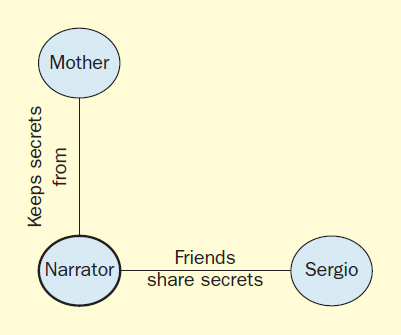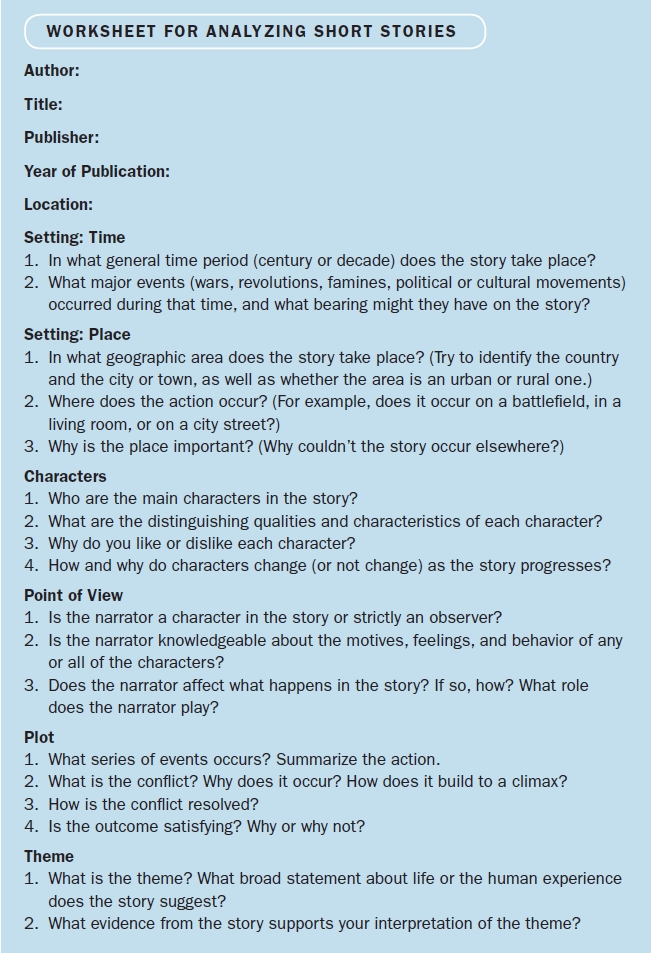ANALYZING SHORT STORIES
A short story is a brief fictional narrative. Short stories are shorter than novels, and their scope is much more limited. For example, a short story may focus on one event in a person’s life, whereas a novel may chronicle the events in the lives of an entire family. Like a novel, a short story makes a point about some aspect of the human experience.
When analyzing short stories, pay particular attention to five key elements.
- Setting
- Characters
- Point of View
- Plot
- Theme
Read the short story “The Secret Lion” before continuing with this section of the chapter. The sections that follow will explain five key elements and how each of them works in “The Secret Lion”
SETTING
The setting of a short story is the time, place, and circumstance in which the story occurs. The setting provides the framework and atmosphere in which the plot develops and characters interact. For example, Charles Dickens’s “A Christmas Carol” is set in nineteenth-century London in December. The setting of “The Secret Lion” is between the arroyo and the mountains just outside Nogales, Arizona. The action occurs near the arroyo and on the golf course.
CHARACTERS
The characters are the actors in the story. They reveal themselves through dialogue, actions, appearance, thoughts, and feelings. Drawing a character map (Figure 25.1) can help you understand the relationships among characters. In the center of a blank piece of paper, write the main character’s name inside a circle. Then add other characters’ names, connecting them with lines to the main character. On the connecting lines, briefly describe the relationships between characters and the events or other factors (such as emotions) that affect their relationship.

The narrator, the person who tells the story, may also comment on or reveal information about the characters. The narrator is not necessarily the author of the story. The narrator can be one of the characters in the story or an onlooker who observes but does not participate in the action. Think critically about what the narrator reveals about the personalities, needs, and motives of the characters and whether the narrator’s opinions may be colored by his or her perceptions and biases.
“The Secret Lion” involves two principal characters: the narrator and his childhood friend, Sergio. Both twelve-year-old boys are playful, spirited, and inquisitive. They explore, disobey, and test ideas. The narrator’s mother is a secondary character in the story.
POINT OF VIEW
The point of view is the perspective from which the story is told. There are two common points of view: first person and third person.
- In the first-person (I, we) point of view, the narrator tells the story as he or she sees or experiences it (“I saw the crowd gather at the cemetery”). A first-person narrator may be one of the characters or someone observing but not participating in the story.
- In the third-person (he, she, they) point of view, the narrator tells the story as if someone else is experiencing it (“Laura saw the crowd gather at the cemetery”). Third-person narrators fall into three categories.
- The third-person narrator reports only the actions that can be observed from the outside; the narrator does not know or report the characters’ thoughts.
- The omniscient, or all-knowing, third-person narrator is aware of and reports on the thoughts and actions of all characters in the story.
- The third-person narrator enters the minds of one or more (but not all) characters and writes about their thoughts and motives.
To identify the point of view, consider who is narrating the story and what the narrator knows about the characters’ actions, thoughts, and motives. “The Secret Lion” is narrated by a first-person narrator who both participates in the action and looks back on the events to interpret them. For example, he says of the preparations for the trip to the mountains, “But we were two young boys with no patience for what we thought at the time was mom-stuff” (para. 15). He also uses a fast-talking narrative style characteristic of twelve-year-old boys, intentionally bending rules of spelling and grammar to achieve this effect. For example, he uses sentence fragments — “Lots of secret signs” (7), “Out in the wilds” (10) — and runs words together or emphasizes syllables to show how they are pronounced — “wild-treacherousraging alligatormouth rivers” (13), “sa-and-wiches” (15). He also uses slang words — “neat” (8) — and contractions to create an informal tone.
PLOT
The plot is the basic story line — that is, the sequence of events and actions through which the story’s meaning is expressed. The plot often centers on a conflict — a problem or clash between opposing forces — and the resolution of the conflict. Once the scene is set and the characters are introduced, a problem or conflict arises. Suspense and tension build as the conflict unfolds and the characters wrestle with the problem. Near the end of the story, the events come to a climax — the point at which the conflict is resolved. The story ends with a conclusion.
For stories with complicated plots that flash backward and forward in time, creating a time line (Figure 25.2), a chronological listing of events, may be helpful.

In “The Secret Lion,” two childhood friends, while playing near an arroyo, discover a grinding ball. They bury the ball but are unable to find it when they return. The narrator recollects an earlier time, when the two boys had planned a trip to the mountains and stopped to have lunch on what they soon discovered was a golf course. The conflict, illustrated by several events, is between the boys’ imaginations and adult realities.
THEME
The theme of a story is its central or dominant idea — the main point the author makes about the human experience. (Recall that themes are large or universal topics that are important to nearly everyone.) Readers do not always agree about a story’s theme. Therefore, in analyzing a short story, you must give evidence to support your interpretation of the theme. The following suggestions will help you uncover clues.
- Study the title. What meanings does it suggest?
- Analyze the main characters. Do the characters change? If so, how, and in response to what?
- Look for broad statements about the conflict. What do the characters and narrator say about the conflict or their lives?
- Look for symbols, figures of speech, and meaningful names (Young Goodman Brown, for example).
Once you uncover a theme, try expressing it in a sentence rather than as a single word or brief phrase. For example, saying that a story’s theme is “dishonesty” or “parent-child relationships” does not reveal the story’s full meaning. When expressed as a sentence, however, a story’s theme becomes clear: “Dishonesty sometimes pays” or “Parent-child relationships are often struggles for power and control.”
One possible theme of “The Secret Lion” is that change is inevitable, that nothing remains the same, and this change brings on a loss of innocence. After the boys discover that they can’t find the buried grinding ball, the narrator hints at this theme: “The ball was gone . . . like everything else that had been taken away” (para. 9). When the boys encounter the two men on the golf course, the narrator again comments on the theme of change: “Something got taken away from us that moment. Heaven. We grew up a little bit, and couldn’t go backward” (26).
Another possible theme of Ríos’s story is that perfection is unattainable. The boys are attracted to the ball because it is perfect: “GuyGodthis is perfect, thisisthis is perfect . . . it’sit’s the best thing we’veeverseen” (5). But once the “perfect” ball is buried, it can never be found again. In much the same way, the boys cannot return to the “heaven” they once knew at the golf course.
Use the worksheet below to guide your analysis of short stories.
